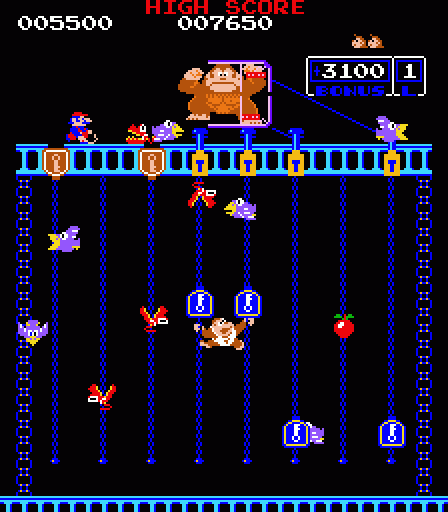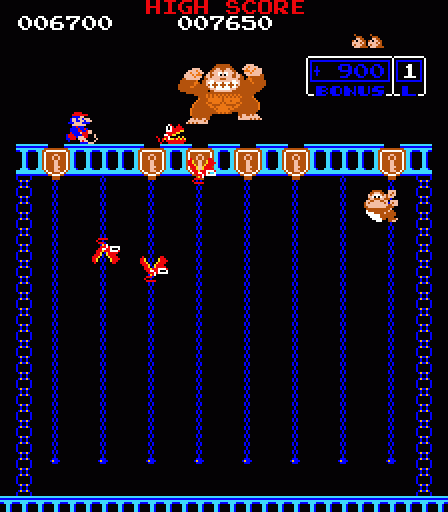The final stage of Donkey Kong Jr. neatly embodies the gestalt of the entire game. It calls to mind the equivalent level of the original Donkey Kong, yet its familiar objects finds itself turned (literally) sideways to make use of Junior’s vertical agility.
You remember the final stage of Donkey Kong, yes? The construction site in which Mario collected rivets to cause the structure to topple, stunning Kong and allowing the hero to rescue Pauline? You’ll find echoes of that here, as Junior works to free his father and get the best of the villainous Mario. Rather than removing bolts, however, you’re instead inserting keys into locks that will unchain Kong. The logic of the level is a little odd, Mario having left the key for each lock hanging from the chain that particular lock binds down, but, you know… video games.
So we have eights chains and six locks. This stage sees Junior in his ideal element, as the action transpires almost entirely on chains spaced evenly across the stage. Gone is the troublesome platforming; once you hop onto the chains at the beginning, there’s really no reason to touch the ground for the remainder of the stage. As such, this level requires an understanding of Junior’s climbing mechanics, but once you do it becomes a joy to navigate: A test of your ability to assert dominances over the game’s control scheme.
Each key you slide to the top of the stage unlocks a portion of Kong’s chains. You can set yourself back if you’re not careful — an unused key can just as easily be pushed down as it can be lifted up — but thanks to the placement of the chains you’re actually better off pushing multiple keys at a time whenever possible.
The stage isn’t without risk; Mario releases birds that behave like the ones in stage two. Actually, they’re even more dangerous than in the previous stage. The other birds made a single U-turn upon reaching the right edge of the screen, but these continue to work their way back and forth, crossing the screen several times at different levels. They’re capable of flying at varied heights at each flight level, too, so you can’t count on any single spot of the screen being a guaranteed safe zone. You need to stay on the move constantly in order to evade the birds, several of which can be on the screen at once (this is where you encounter the risk of accidentally pushing the keys back down as you slide to stay clear of their flight path).
In addition to the lateral threat posed by the birds, Junior also has to contend with several of the Snapjaw traps that climb up and down the chains. These are the red variety, meaning they move more slowly and don’t respawn like the blue ones do — but also unlike the blue ones, they’ll double back at the end of a chain and climb back to the top of the screen, meaning you need to watch for danger moving toward you in all four directions. It’s a simple combination of challenges, but effective: Between the birds and the Snapjaws, Junior’s enemies create a thorough dragnet of danger that covers practically every inch of the screen.
Nevertheless, because it emphasizes the skill set around which the game is primarily designed, the final level is much less difficult than the second and third. That’s not a knock against the stage; on the contrary, it’s a good thing. Much of what made the earlier levels so difficult stemmed from the inconsistency and unreliability of Junior’s platforming controls, and the fact that the protagonist was so poorly suited to some of those situations. Here, we have a stage in which the game’s mechanical innovations are put to their full use, forcing you to fully grasp the differences between quick climbing (with a spread grip on multiple chains) and a quick descent (with a double-handed grip on a single chain).
It’s a great finale to the game, though the fact that this all-climbing scenario didn’t appear earlier is a real shame. It feels like Donkey Kong Jr. ends right as it’s finding its groove.
And that’s basically the problem with Donkey Kong Jr. in a nutshell. While it’s an admirably ambitious attempt at creating a sequel that didn’t simply coast on the success of its predecessor, it doesn’t live up to the high standard set by the original Donkey Kong. It lacks Kong’s purity of design and focus, adding new skills for the player to master. That’s a good thing to be sure, but Junior’s expanded repertoire comes at the expense of his core platforming abilities. He’s both clumsier and more complex than Mario, and the layout of several of the stages betray this fact with their unwillingness to let go of Donkey Kong‘s basic platforming structure.
While many of Donkey Kong Jr.‘s sequences play cleverly off scenarios from the first adventure, they lack that final touch of perfectionism that makes so many of the games surrounding it on either side of the franchise true classics. It’s a good game bordering at times on excellent — but it’s not at all the masterpiece its predecessor was.
Still, you shouldn’t write it off. It allowed Shigeru Miyamoto and his peers to experiment with new ideas, get a sense of what worked and what didn’t, and double down on the series’ strengths. Not coincidentally, many of its elements and concepts would show up further down the road.


While I admit the climbing mechanics are fun and the stage is a nice playground for them, I probably would’ve liked the last stage better if the third stage had been stronger. As is, you go straight from a stage that was only about going left to right and right to left while avoiding sparks to one where you’re shoving keys into holes in a square room with eight chains of the same length while avoiding claptraps and birds. You’re going from one straightforward and boring stage to one that looks straightforward and boring.
Oh well, at least the US arcade version threw a spanner in the level works again and you end up playing Stage 4 as your second stage the first time through. It’s worth it just to see D.K. thrash Mario.
I wonder if the arcade or NES hardware was capable of having the player swing a vine back and forth.
Anyhow, here’s a level in Donkey Kong 94 that evokes this stage. I wonder how Mario got as good at climbing ropes as DK Jr.
http://youtu.be/uEW14WmOtD8?t=5m59s
In the above video, skip ahead to 6:00.
As a kid I liked Donkey Kong Jr. more than the original, probably because I was better at it. The original is clearly superior in retrospect, but I still love the hell out of DK Jr.’s final stage. It’s a shame that it took until DK ’94 to have any follow up to these mechanics. There’s a lot of DK Jr.’s DNA in DK ’94, and clearly a lot of the original, too.
Donkey Kong 3, not so much. 😛
I´m guessing that by his lack of Mario you won´t be covering Donkey Kong 3, or will you Jeremy? That has to be one of the worst sequels of all time, so bad and so divorced from the variety and innovation of its predecessors it puzzles me.
Was it even designed by Miyamoto? I really doubt it, and the absence of Mario in that boring and generic shooter hints of him not being involved at all. I smell a shameless franchise cash-in by some B-grade designer at Nintendo while Miyamoto was appointed to work on his first Famicom masterpieces .
Such a simple and repetitive game as DK3 should´ve been the one released in 1981, and the masterful first Donkey Kong should be the third and crowning jewel of a very unique trilogy. DK Jr. is really the middle ground in both cases, but as it stand with DK3 ending it with such a de-evolution, it makes DK as an arcade series feel really weird and derailed…
I hope you will briefly dissect DK3 nonetheless, at least to clear the mystery of why it was so bad.
I’d love to see DK3 covered, just for completion’s sake, even though it probably has little to nothing to do with the grander “Anatomy of Super Mario” scheme of things.
It would be nice to see these sorts of mechanics applied somehow to more modern DK games, like in the DKC series.